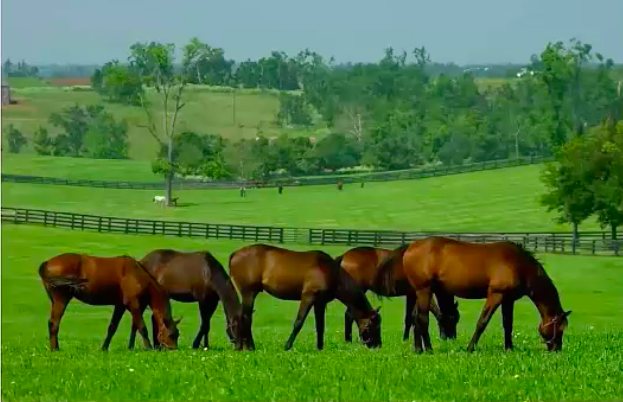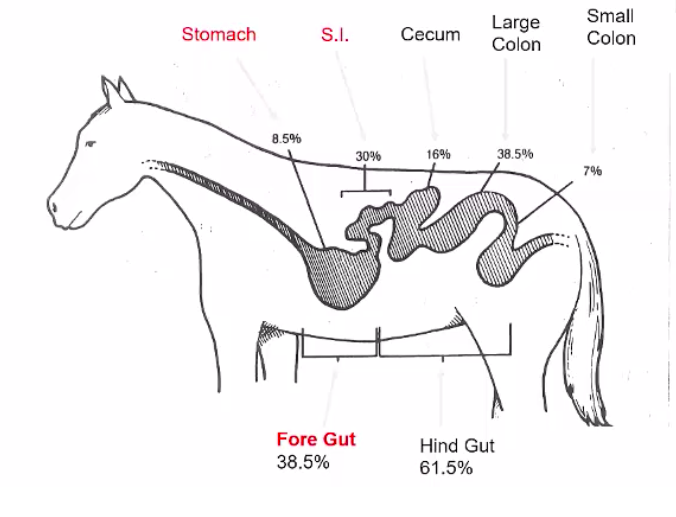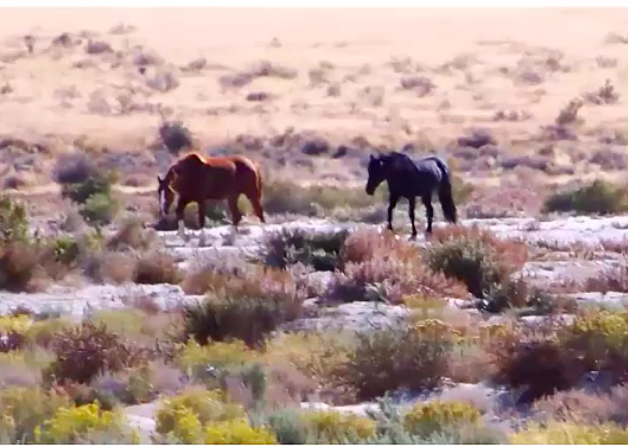DIGESTIVE ANATOMY AND PHYSIOLOGY OF THE HORSE – PART 1
Based on Equitopia webinar presented by Dr Clair Thunes
The horse’s digestive tract is a complicated system and keeping it functioning optimally is a very important aspect of equine welfare. The horse’s diet is significantly different to our own which has a big impact not only on the food they eat but also how and when they eat it. Understanding the basics of how your horse’s digestive system works can help us make better decisions when it comes to our horse’s diet and consequently our horse’s general health. In last month’s webinar, Dr. Clair Thunes, Equitopia’s lead nutritionist delved into the basic anatomy and physiology of the horse’s digestive system.

THE EVOLUTION OF THE HORSE
In order to understand why the horse’s digestive system is built like it is, we need to look at the horse’s evolution, says Dr. Thunes. Horses evolved on vast plains, in a barren, harsh environment where they had to travel long distances each day to get the calories they required. The main food source was not lush grass, but low-calorie, fibrous forage. The bright green, lush pastures that some of our horses live on today is a huge contrast to where they actually came from. The problem with lush pastures is that they will very easily put weight on a horse. If this is a growing thoroughbred, it might not be a problem, but it can be a big problem when we are dealing with horses who naturally put on weight quite quickly and this abundance of calories and sugars can lead to problems. On the other hand, many modern horses live in stalls or in small dry lots and get very limited, if any, access to pastures. So, horses evolved constantly moving, constantly eating low calorie forage, and yet the way we keep them now, living in stalls and getting fed twice a day, does not reflect their evolution. Because their digestive anatomy and physiology has evolved around their lifestyle, this modern way of keeping horses just does not work for their digestive tracts, Dr. Thunes points out.
If we look at a diagram of the horse’s digestive tract (below), we can see that the hindgut represents the majority of the digestive system, meaning that microbial fermentation, which takes place in the hindgut is by far the most prevalent way of digesting food. Using microbial fermentation, the horse digests tough forages, which makes sense when you remember his evolution.
 THE HORSE’S MOUTH
THE HORSE’S MOUTH
A part of the digestive tract that we often forget about is the horse’s mouth – that’s where it all begins. The horses use their incisor teeth to cut forage and their premolars and molars to grind it. While they are chewing, three pairs of glands secrete saliva to moisten the food. Equine saliva contains a high amount of calcium and bicarbonate, which act as a buffer in the stomach, where we find stomach acid. Saliva is only secreted when the horse is chewing, which means the more they chew, the more they are able to buffer the stomach acid, that is being released constantly. This works really well if the horse is grazing throughout the day. However, if we feed our horse two meals and they are only eating for two hours a day, they will only be producing saliva during this time. But the acid is going to be produced continually, which has a big impact on the buffering capacity.
THE STOMACH
The stomach is relatively small, only about two to four gallons in an average horse. Feed passes through the stomach in six hours after feeding. If we want to keep the stomach from being empty, we need to be feeding at a minimum of 6-hour intervals. In the stomach, the protein and fats get pre-digested and the feed gets mechanically broken up. We can divide the stomach into the upper third and the lower two thirds. These two parts differ from each other in the type of cells they are covered in. The upper portion is covered in squamous cells and the lower one is covered in glandular cells. The glands in the glandular cells secrete the hydrochloric (stomach) acid and mucous and bicarbonate, which protects them from the acid that they are secreting. The non-glandular squamous cells are not protected from acid, as they never really come in contact with it if a horse is constantly grazing – the forage will create a barrier between the two portions. However, if the stomach holds no forage, the acid can find its way onto the sensitive upper third of the stomach, creating ulcers.
Equine Gastric Ulcer Syndrome (EGUS) is very common in domestic horses and the current treatment approach includes blocking gastric acid secretion and raising the pH in the stomach, which is done with different drugs. In addition to this, nutrition and management is also very important to decrease the severity of ulcers and to reduce their recurrence. Some risk factors for EGUS are intense exercise (especially on an empty stomach), meal feeding, stall confinement and starchy feeds. Clinical signs include poor performance, poor coat, picky eating, colic, cribbing and an inability to maintain weight. Dr. Thunes advises to contact your vet if your horse is displaying any of these symptoms.
PART TWO OF THIS BLOG IS AVAILABLE FOR EQUITOPIA MEMBERS – SIGN UP HERE
Equitopia members may continue to the next part of this blog post here: https://www.equitopiacenter.com/digestive-anatomy-and-physiology-of-the-horse-part-2/





